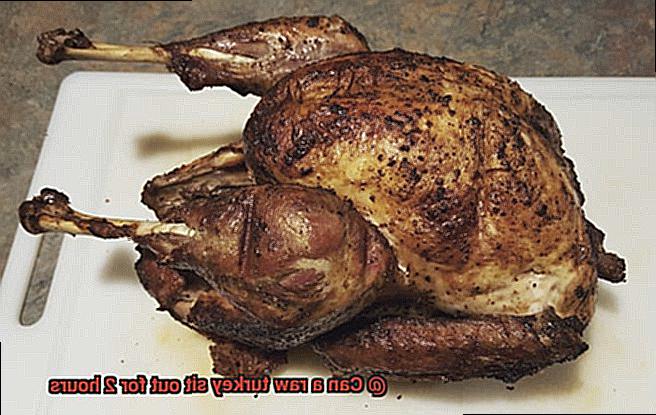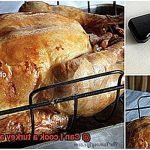Thanksgiving is almost here, and it’s time to start thinking about the most important part of the holiday – the food. As you plan your menu and strategize your cooking schedule, there’s one question that might be weighing on your mind: can a raw turkey sit out for 2 hours?
We’ve all heard horror stories about food poisoning from improperly stored or cooked poultry. But what about a big bird like a turkey? Is it safe to leave it out on the counter for a little while?
In this post, we’re going to dive deep into the science of bacterial growth and explore the USDA’s guidelines for safely handling poultry. We’ll also give you some practical tips for keeping your turkey safe and delicious.
By the time you finish reading this article, you’ll be armed with all the knowledge you need to ensure that your holiday meal is both tasty and bacteria-free. So grab a pen, put on your chef’s hat, and let’s get started.
Contents
The Dangers of Leaving a Raw Turkey Out for Too Long
As Thanksgiving approaches, many of us eagerly anticipate the delicious meals that come with it, especially the turkey. However, as much as we focus on creating a mouth-watering feast for our loved ones, we must prioritize food safety first. One of the most significant risks to food safety when cooking a turkey is leaving it out at room temperature for too long. In this post, we’ll explore the dangers of leaving a raw turkey out for too long and provide tips on how to keep your turkey safe and delicious.
Raw turkey, like any other raw meat, is susceptible to bacterial growth when left out in the open for an extended period of time. The “danger zone” for bacterial growth is between 40°F and 140°F. If a raw turkey sits out for more than two hours within this temperature range, there is a high risk of bacterial contamination that can cause foodborne illnesses.
The bacteria that are commonly found on raw poultry include Salmonella and Campylobacter. These bacteria can cause severe symptoms such as diarrhea, fever, nausea, and vomiting. In some cases, these illnesses can even lead to hospitalization or death.
To prevent the dangers of leaving a raw turkey out for too long, planning ahead is crucial when cooking. Here are some tips to ensure your turkey remains safe:
- Thaw your turkey in the refrigerator or in cold water but never at room temperature.
- Keep your raw turkey refrigerated until you’re ready to cook it.
- Reduce the amount of time that the turkey spends outside of the refrigerator during preparation and cooking.
If you need to transport raw turkey, make sure to keep it in a cooler with ice packs to keep it at a safe temperature.
It’s essential to follow proper food safety guidelines when cooking a turkey to ensure that you and your guests stay healthy and safe. The USDA recommends that raw poultry should not be left out at room temperature for more than two hours. If you do accidentally leave your raw turkey out for too long, it’s best to be cautious and discard it. Although it may be tempting to save the meat by cooking it thoroughly, it may not kill all of the harmful bacteria that may have grown on it.
Temperature Danger Zone for Bacterial Growth
What exactly is the temperature danger zone? It’s the range of temperatures between 40°F and 140°F where bacteria thrive and multiply at an alarming rate. That’s why it’s essential to keep perishable foods out of this range as much as possible.
Now, let’s focus on raw turkey. Leaving it out at room temperature for more than two hours can rapidly increase the risk of foodborne illness. This is true even if you’ve covered the turkey or wrapped it in foil.
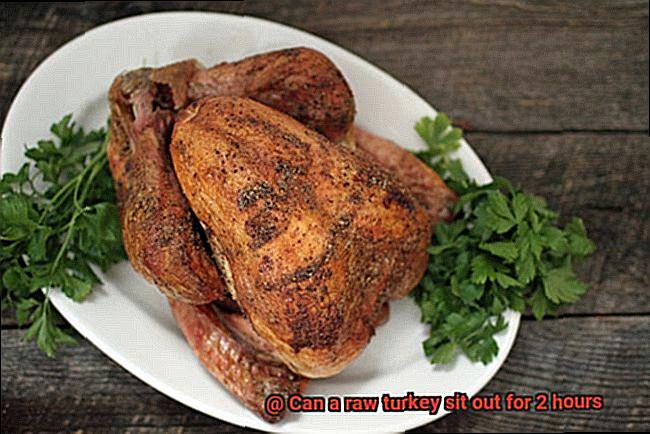
To avoid this scenario, it’s best to keep your raw turkey refrigerated until ready to cook. If you’re transporting it, pack it in a cooler with ice or frozen gel packs to keep it below 40°F. Also, remember that the two-hour rule applies only to the time raw turkey spends at room temperature, not the total time it has been out of refrigeration.
If you’ve thawed your turkey in the refrigerator, you can leave it there for up to two days before cooking. But if you’ve thawed it in cold water or the microwave, cook it immediately.
Here are some key points to keep in mind:
- The temperature danger zone is between 40°F and 140°F.
- Raw turkey should not be left out at room temperature for more than two hours.
- Proper storage and transportation are crucial to prevent the growth of harmful bacteria.
- If you’ve thawed your turkey in the refrigerator, it’s safe to leave it there for up to two days before cooking.
- If you’ve thawed your turkey in cold water or the microwave, cook it immediately.
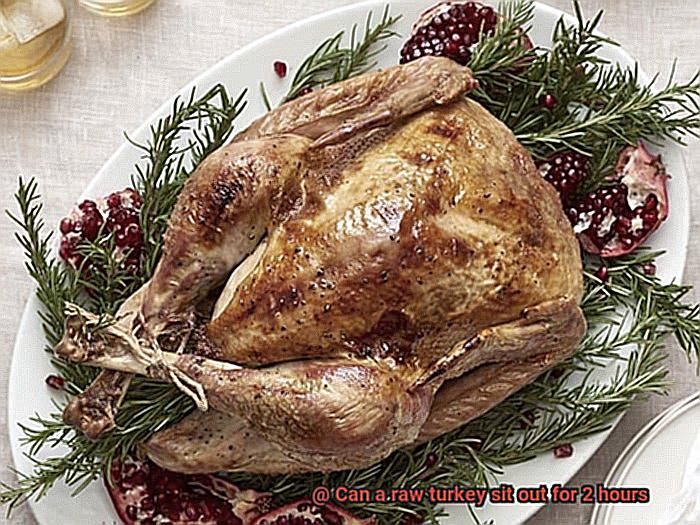
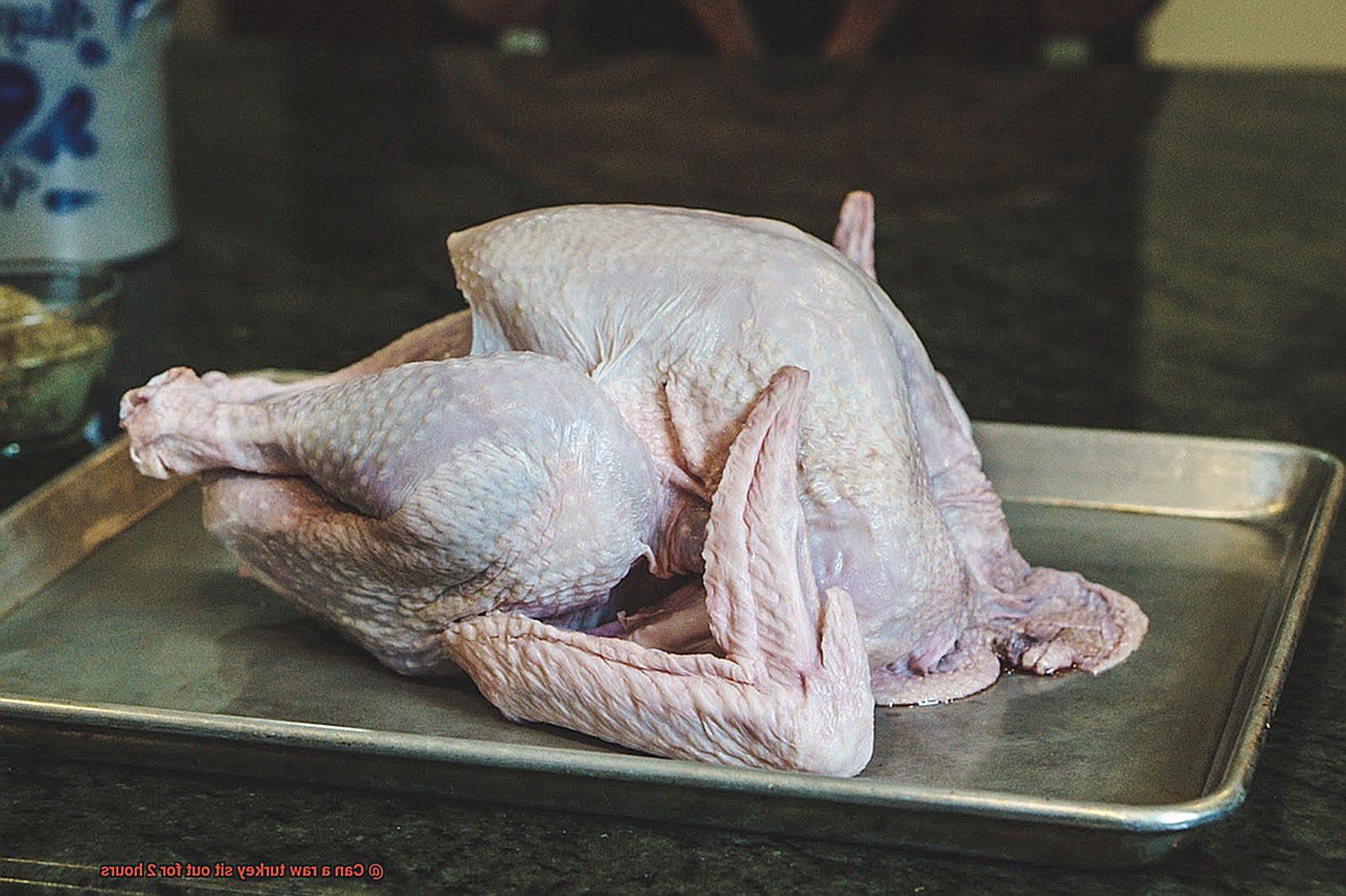
How to Store and Transport a Raw Turkey Safely
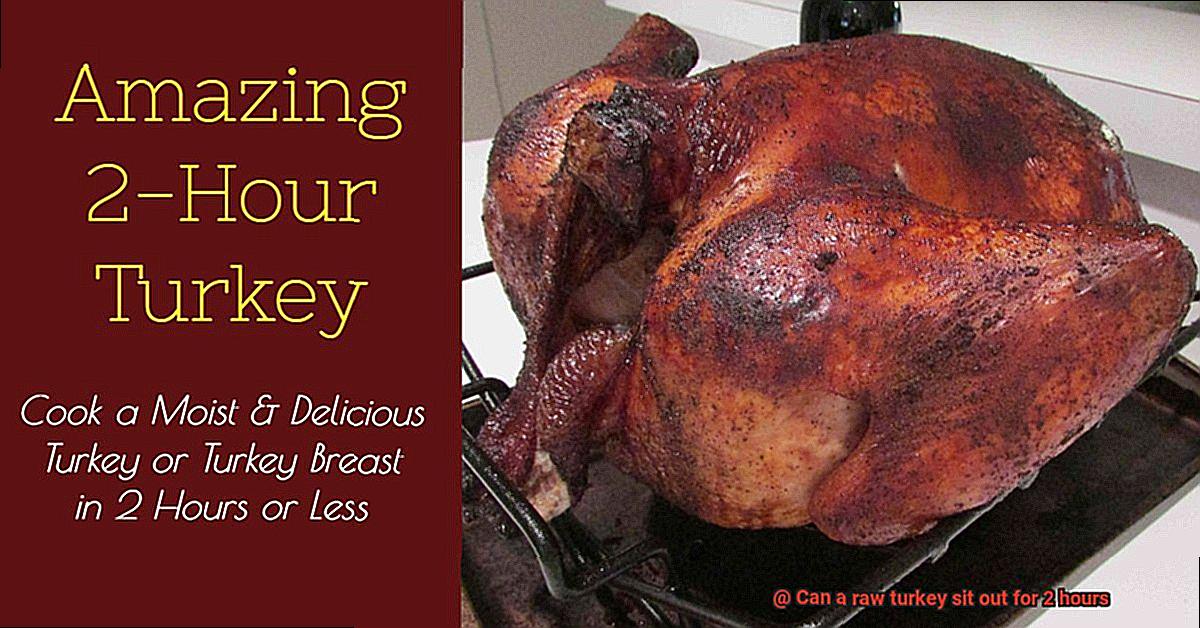
If you’re planning to cook a turkey for the holidays, it’s essential to store and transport it safely to avoid foodborne illness. Raw turkey is highly perishable and can harbor harmful bacteria that can cause serious health problems. Here are five sub-sections to help you learn how to store and transport a raw turkey safely.
Keep it Cold
The first and most important thing to consider when transporting and storing raw turkey is temperature. Bacteria thrive in the temperature danger zone between 40°F and 140°F, so it’s vital to keep the turkey cold. Store raw poultry at 40°F or below, which is the temperature range for your refrigerator. When transporting a turkey, use a cooler with ice packs or frozen gel packs to keep it at a safe temperature.
Package it Properly
When transporting a raw turkey, ensure it’s packaged correctly. If you’ve purchased a raw turkey from the grocery store, it may come in a package designed for refrigeration. If you’re transporting a turkey that’s not in a refrigerated package, wrap it tightly in plastic wrap or aluminum foil and place it in a leak-proof container.
Store it Properly
When storing a raw turkey in the refrigerator, always place it on the bottom shelf so that any juices don’t drip onto other foods and contaminate them with harmful bacteria. Also, make sure that the turkey is placed in a pan or dish to catch any drips. If you need to store the turkey for more than two days, freeze it instead.
Thaw it Safely
To thaw your turkey safely, avoid leaving it out on the counter at room temperature, as this can encourage bacterial growth on the meat’s surface. Instead, thaw the turkey in the refrigerator or by using cold water. When thawing in the refrigerator, allow about 24 hours of thawing time for every 4-5 pounds of turkey. If using cold water, place the turkey in a leak-proof plastic bag and submerge it in cold water. Change the water every 30 minutes to ensure that it stays cold.
Cook it Thoroughly
Cooking your turkey thoroughly is crucial to kill any bacteria that may be present. Use a meat thermometer to ensure that the thickest part of the turkey reaches a temperature of 165°F. Avoid stuffing your turkey, as this can increase the risk of bacterial growth.
Refrigerating a Raw Turkey Before Cooking It
As you prepare for your next holiday feast, don’t forget the importance of properly refrigerating your raw turkey before cooking it. Not only does refrigeration keep your turkey fresh, but it also prevents harmful bacteria from multiplying and causing foodborne illnesses.
To ensure that your turkey stays safe to eat, it’s recommended that you store it in the refrigerator immediately after purchasing or thawing it. The USDA advises keeping the turkey at a temperature of 40°F or below. It’s also important to store your turkey in a container that can catch any juices that may leak out, as this will prevent cross-contamination with other foods.
If you plan to brine your turkey, which involves soaking it in a saltwater solution for several hours, make sure you do so in a refrigerated area. Brining can add flavor and tenderness to your turkey, but if done at room temperature, harmful bacteria can grow and cause foodborne illness.
It’s important to note that refrigeration alone cannot eliminate all bacteria from raw turkey. Proper food handling and cooking practices are also crucial to ensure that your turkey is safe to eat. For example, always cook your turkey to an internal temperature of 165°F with a meat thermometer.
To summarize, here are some key points to remember when refrigerating a raw turkey before cooking it:
- Store the turkey in the refrigerator immediately after purchasing or thawing it.
- Keep the turkey at a temperature of 40°F or below.
- Use a container that can catch any juices that may leak out.
- If brining, do so in a refrigerated area.
- Follow proper food handling and cooking practices to ensure safety.
When to Cook a Raw Turkey?
When it comes to Thanksgiving, the star of the show is undoubtedly the turkey. But when should you start cooking your raw turkey? As an expert on this subject, I can assure you that timing is everything when it comes to ensuring a delicious and safe feast.
The first step to a perfectly cooked turkey is proper refrigeration. Keep your raw turkey at or below 40°F until you’re ready to cook. And once you take it out of the fridge, don’t let it sit at room temperature for more than two hours. Bacteria can grow rapidly after that time, leading to foodborne illness.
Now onto cooking time. A general rule of thumb is to cook your turkey for 13-15 minutes per pound at 350°F. For example, a 12-pound turkey should take approximately 2.5-3 hours to cook. However, this is just a guideline, and it’s crucial to use a meat thermometer to ensure that the internal temperature reaches 165°F – the safe zone for poultry.
If you’re planning to stuff your turkey, add an extra 30-45 minutes of cooking time. And if you’re using a convection oven, keep an eye on your bird as it may cook faster than in a conventional oven.
Aside from the cooking time, you’ll also need to consider any other dishes that will be sharing oven space with your turkey. Make sure everything has enough time and space to cook properly and be served at the same time.
Procrastination is not your friend when it comes to cooking a turkey. Starting early in the day will give you plenty of time to prepare and avoid undercooked or overcooked turkey – both dangerous and unappetizing outcomes. Plan ahead and enjoy a stress-free Thanksgiving.
To recap, here are the key points:
- Proper refrigeration is essential
- Use a meat thermometer to ensure the internal temperature reaches 165°F
- Add extra cooking time if stuffing the turkey or using a convection oven
- Consider other dishes sharing the oven
- Start cooking early in the day to avoid undercooked or overcooked turkey
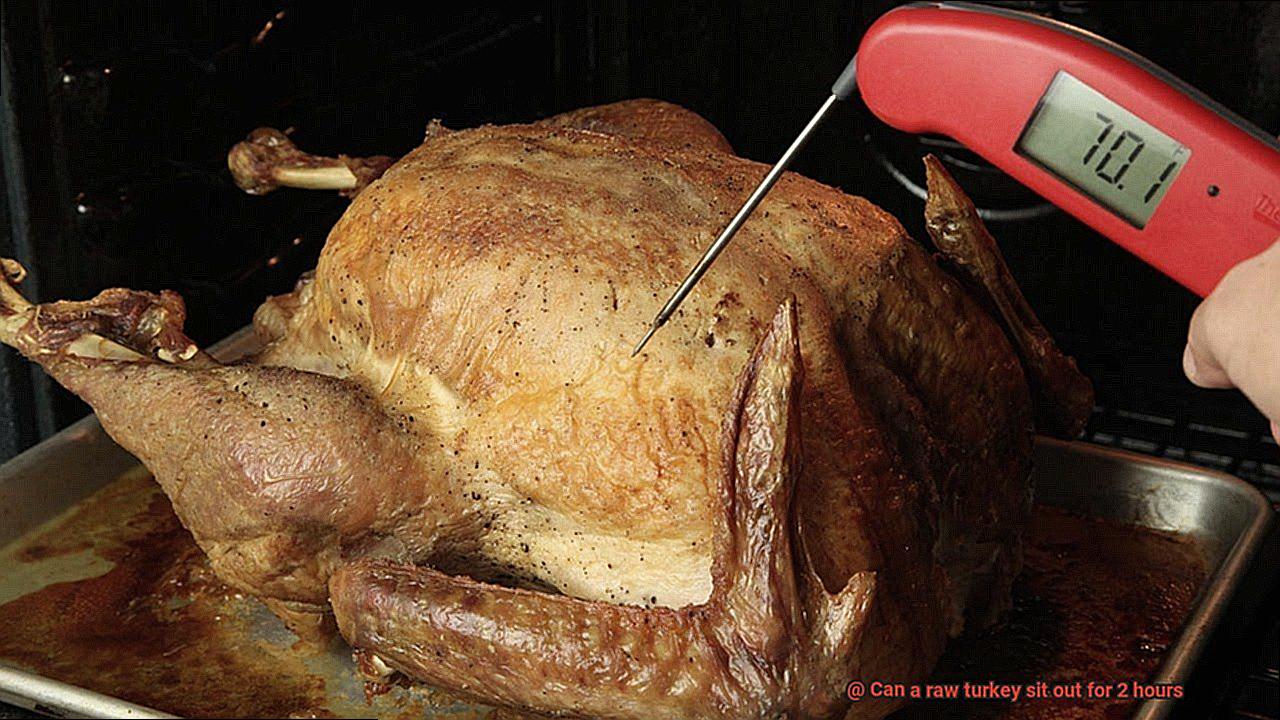
How to Tell if Your Turkey is Cooked Properly?
Cooking a turkey can be intimidating, especially if you don’t know how to tell if it’s cooked properly. But don’t worry, we’ve got you covered. Here are five sub-sections to look out for to ensure that your turkey is cooked to perfection.
Use a Meat Thermometer
The most reliable way to check if your turkey is cooked properly is by using a meat thermometer. The USDA recommends cooking your turkey to an internal temperature of 165°F (75°C) in the thickest part of the bird. Insert the thermometer into the breast or thigh without touching the bone to get an accurate reading. Remember that different parts of the turkey may reach this temperature at different times, so it is recommended to check multiple areas such as the thigh, breast, and wing.
Check the Juices
Another way to tell if your turkey is fully cooked is by checking the juices. When the turkey is cooked correctly, the juices should run clear instead of pink or red. Pierce the thickest part of the turkey with a fork or knife and observe the color of the juices that come out. If they are clear, then your turkey is ready to serve.
Wiggle the Leg
You can also check if your turkey is cooked by wiggling its leg. If it moves easily and feels loose, then it is likely that it is fully cooked. However, this method is not as reliable as using a meat thermometer.
Look at the Color and Texture
The color and texture of your turkey can also give you an idea of whether it’s cooked properly or not. A fully cooked turkey should have a golden brown skin and meat that is white without any pinkness. The meat should also be firm and not have any pink or red areas. If you notice any pink or red areas, then put your turkey back in the oven and continue cooking until it reaches 165°F (75°C) in the thickest part of the bird.
Check Stuffing Temperature
If you stuffed your turkey, make sure that the stuffing has reached an internal temperature of 165°F (75°C) as well before serving. The stuffing may not reach this temperature if it’s dense or packed tightly into the bird, so it’s recommended to cook the stuffing separately.
Food Safety Tips for Grilling and Serving a Raw Turkey
Grilling and serving a succulent turkey is the highlight of any festive meal. However, it’s crucial to keep food safety at the forefront to prevent any foodborne illnesses from ruining your holiday. Here are some essential tips to ensure that your turkey is safe to eat:
Keep Your Turkey Refrigerated
It’s important to keep your raw turkey refrigerated until ready to cook. Bacteria can grow rapidly between 40°F and 140°F, which is known as the “danger zone.” Raw turkey should not be left out at room temperature for more than two hours as this can lead to harmful bacteria growth like Salmonella and Campylobacter.
Thaw Your Turkey Safely
Never thaw your turkey at room temperature as this allows bacteria to multiply. Instead, thaw it safely in the refrigerator or in cold water that is changed every 30 minutes.
Cook Your Turkey Thoroughly
Cooking your turkey thoroughly is the most critical step in ensuring its safety. The internal temperature of the thickest part of the meat should reach 165°F before you consider it safe to eat. Use a meat thermometer without touching the bone to check the temperature.
Avoid Cross-Contamination
Raw turkey can easily cross-contaminate other foods if proper precautions are not taken. Use separate cutting boards and utensils for raw meat and other foods, and always wash your hands thoroughly before and after handling raw turkey.
Follow Specific Guidelines
It’s important to follow specific instructions or guidelines provided by your local health department or food safety organization. This can include recommendations on how to prepare, store, and cook your turkey safely.
Uz7RD11JoRo” >
Conclusion
In conclusion, the safety of your Thanksgiving turkey is paramount to prevent any potential foodborne illnesses that can put a damper on your holiday. To avoid bacterial growth, it’s crucial to keep raw turkey refrigerated until you’re ready to cook it as the “danger zone” for bacteria is between 40°F and 140°F.
Thawing should be done safely in the refrigerator or cold water that is changed every 30 minutes. Cooking your turkey thoroughly with a meat thermometer reaching an internal temperature of 165°F is non-negotiable.
To avoid cross-contamination, use separate cutting boards and utensils for raw meat and other foods. Ensure you wash your hands thoroughly before and after handling raw turkey. Additionally, following specific guidelines provided by local health departments or food safety organizations is vital.
Proper storage and transportation are necessary when cooking a turkey. This includes keeping it refrigerated below 40°F, packaging it correctly, storing it properly in the refrigerator or freezing if needed, thawing safely, and cooking thoroughly. Starting early on Thanksgiving day will give you ample time to prepare without undercooking or overcooking your bird.
By adhering to these tips and guidelines, you’ll guarantee a safe and scrumptious holiday meal for you and your loved ones.

